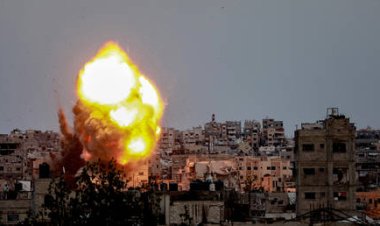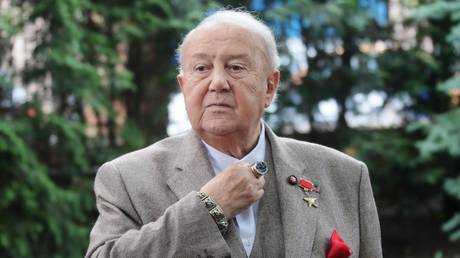The Biggest Threats to the U.S. Aren’t What You Think
The Pentagon is increasingly waking up to serious national security hazards that aren’t nukes, tanks and bombs. A leading expert explains what the U.S. needs to do about these non-traditional threats.


In early 2020, the rapid spread of Covid-19 changed the lives of people around the world. But at the Pentagon, the virus carried a special warning.
“The pandemic was, in many ways, a wake-up call that we need to focus on military challenges and non-traditional threats,” said Anca Agachi, associate director for the Transatlantic Security Initiative at the Atlantic Council who studies non-traditional threats. “It changed the meaning of security into a more expansive definition.”
Non-traditional security threats is a broad term, but it essentially means hazards not created by the military that can shape conflict. Think biothreats like Covid-19, but also climate change, irregular migration and food and energy insecurity. Also on the list, Agachi said: disinformation and tech coming out of the private sector.
As globalization makes the world more interconnected, we’re seeing more and more of these threats emerging, Agachi said. But while they affect U.S. national security in a big way, it’s not solely the job of the military to fix them. Often the solution comes from various agencies actually communicating with each other, which isn’t something the federal government is known for. Given that these threats could define the next century, “the U.S. will have to be significantly better at quickly anticipating some of these challenges,” Agachi said.
This interview has been edited for length and clarity.
Lee Hudson: As the Pentagon focuses on the war in Ukraine and the rise of China, the U.S. is investing in airplanes, missiles, ships and satellites to prepare for a large-scale conflict. But there are other threats to national security. Could you help us dig deeper into what you see as the most significant non-traditional threats?
Anca Agachi: There are a few issues that the U.S. should keep an eye on. And to its credit, the administration has captured these quite well in the recently released National Defense Strategy.
Top of mind for me is climate change, which has significant impacts on the warfighting forces' ability to carry out its operations and the environment in which the U.S. military is operating.
Further, the impact of emerging technologies [such as artificial intelligence or quantum computing] and their potential exploitation by adversaries, such as China, Russia and others.
Another issue I'm watching closely is a direct result of the Russian war in Ukraine. Growing food insecurity combined with displacement and migration, conflict and illegal trafficking — building up this concoction of crises that can potentially be much more devastating to the Earth than we initially expected.
Hudson: Why are these non-traditional threats popping up now?
Agachi: These result from the world's increased interconnectedness and globalization and the pressure we're putting on our systems.
For example, climate change results from decades of investment and economic activity when its impact on the environment was not considered. But now, we've reached a point where runaway climate change can have dire consequences both in terms of immediate loss of life, as we've seen in countless extreme weather events, and destabilizing societies [longterm].
Covid-19, in many ways, was the bellwether where we saw for the first time what can happen when an uncontrolled transnational challenge pushes across borders and the havoc it can wreak around the world.
Hudson: Could you elaborate on each of your top non-traditional threats that you believe the U.S. military will face in the future?
Agachi: Climate change will impact U.S. warfighting abilities through force readiness, installations and the changing environment, such as the Arctic emerging as a new geopolitical area.
Another non-traditional threat to keep in mind is irregular migration, which other states can weaponize. For instance, in Lithuania in the summer of 2021. Belarus decided to send migrants to its border with Lithuania to create challenges and achieve political objectives.
Biothreats are another challenge in the future. In the last couple of years with Covid-19 we've seen how important it is to be prepared for the emergence of viruses, whether natural or man-made. But we also have to keep in mind the fact that norms for using biological weapons are eroding, as we have seen in Syria and Ukraine.
Hudson: Why are non-traditional threats difficult for the military to counter?
Agachi: There are a couple of reasons. First, the category is broad, so it's hard to pin it to something specific. We've made great progress in past years to try and understand not only what these threats are but also how they intersect and what their manifestations can be.
There's still a lot more work to do. So that would be [the] number one [thing we have to do to counter them]: identifying the threats and mapping out how they manifest their primary, secondary and tertiary consequences.
The other part is many of these [non-traditional threats] require an integrated response. The Pentagon plays an important role, for example, in emerging defense technologies, but it can't be only the Pentagon, right? Other executive branch institutions, the legislative branch and the private sector must be involved to respond. An integrated, whole-of-government response is generally hard to develop and hard to implement, defining the right responsibility, defining the suitable mechanisms for action and the right tools.
The U.S. will have to be significantly better at quickly anticipating some of these challenges.
Hudson: What can the Pentagon do to counter these non-traditional threats?
Agachi: For many of these threats, the Pentagon cannot or should not be the first, or even the last line of defense — rather, the United States and allies should pursue a whole-of-government approach that includes diplomatic and economic tools of statecraft alongside the military.
That is because the causes of many of these threats are structural, stemming from economic inequality, environmental degradation and governance gaps. Therefore, targeting the root causes of these threats and preventing them from emerging in the first place is more financially and strategically effective than just responding with military tools.
Take pandemics, for example. A true comprehensive response should include extensive financial investments in public health, the protection of nature to avoid the emergence of zoonotic diseases, well-developed strategic communications campaigns to fight disinformation, extensive information-sharing with other countries to map the evolution of such a threat and a revamping of the global governance architecture to allow for more cooperation on these issues.
However, when we do need the Pentagon to be involved, I think there are a few general, cross-cutting principles to follow in preparing for and responding to non-traditional security threats: Leverage strategic foresight methodologies and wargaming that can help the Pentagon better anticipate the threats ahead and how they may impact its operations. Invest in better situational awareness and early warning systems to detect these threats as they emerge, whether they are born naturally or hatched by adversaries. Share information in the appropriate fora, especially with allies and partners. Build resilience in military installations, [whether] withstanding the worst effects of climate change or in securing DoD networks against cyberattacks. And finally, training and building the capacity of the force for the future so they can be responsive, flexible and adaptable in a fundamentally changed security environment.
Hudson: How did the global pandemic shape the Pentagon's approach to non-traditional threats?
Agachi: The pandemic was, in many ways, a wake-up call that we need to focus on military challenges and non-traditional threats. It changed the meaning of security into a more expansive definition.
Hudson: From the war in Ukraine, what can the Pentagon learn about non-traditional threats?
Agachi: It's crucial that the Pentagon not only learns lessons from Ukraine but also learns the right lessons. For example, the Russian use of energy to make battlefield advances is something we'll see in the future.
Another interesting observation is that everyone expected early on to see the Russian disinformation machine at work. Instead, we saw a phenomenal phase for the Ukrainians of owning the narrative and getting ahead of Russian disinformation.
Hudson: Do you think the U.S. government is adequately organized to respond to these threats?
Agachi: There is potential for better structures and coordination across governmental institutions to monitor them and then share information about their development. For example, an interagency process housed within the National Security Council to track these types of threats. The interagency mechanism would ensure that not one specific institution handles this task.
This is a common challenge for many governments, not only the United States, of being better at anticipating threats on the horizon before they take place.
Discover more Science and Technology news updates in TROIB Sci-Tech











